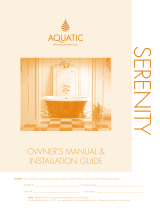
16 Aquatic
Serenity DriftBath™ Owner's Manual & Installation Guide
WATER QUALITY
CHEMICAL & WATER QUALITY
Owners of fill and drain whirlpool bathtubs need to know basic information concerning water quality, how it affects
the performance and enjoyment of the operation of their tubs, and steps that can be taken by the owner to correct
related problems. Important issues are the microbiological and chemical quality of the water.
1. Microbiological Quality
Microbes are present in water supplied by individual wells or water systems and even in the air around us. These
microbes are usually in amounts below what is noticeable. Microbes from the water or air or from a bather’s body
may settle on wet surfaces such as bathtub surface or piping system where they can grow in numbers. With regards
to whirlpool bathtubs, brown/black fungi/mold or pigmented (colored) bacteria can be noted.
Fungi/Mold - Fungi and mold are always present. Usually the levels are such that we don’t notice them. When
moisture and temperature are sufficient, the organisms will grow to levels that we may smell and/or see. The best
examples of such growth is the very common black growth on the bottom of shower curtains. The best solution to
keep these surfaces free from fungi/mold growth is frequent cleaning.
Pigmented Bacteria - A pinkish substance may appear on bathroom fixtures that is very persistent, appearing in the
shower, sink and along the water line of toilet bowls. The residue is less likely a problem associated with water quality
than with naturally occurring airborne bacteria. The bacteria may produce a pinkish film, and sometimes a dark gray
film, on surfaces that are regularly moist, including toilet bowls, shower heads, sink drains, and tiles. The problem
is more common in humid areas of the country. In any particular case, the determination of the exact species of
bacteria causing the problem would require lengthy and costly laboratory testing; however, most experts believe the
bacteria responsible is Serratia Marcescens. These bacteria thrive on moisture, dust and phosphates, and are widely
distributed in soil , food and also in animals. The best solution to keep these surfaces free from the bacterial film is
continual cleaning. A chlorine containing compound is the best cleaner. Avoid abrasives to limit scratching fixtures,
which will make them even more susceptible to bacteria.
2. Chemical Quality
The water supplied by individual wells or water systems always contains chemicals, usually in amounts below those
which the consumer would notice. Examples of such chemicals, which are of potential concern for the owners of
whirlpool bathtubs, are calcium and magnesium salts, copper, iron, manganese and sulfates. When these chemicals
are present in sufficient amounts, they may cause problems in whirlpool bathtubs. You should contact your water
supply or treatment company and follow their suggestions for treatment.
Calcium and Magnesium Salts - Collectively, the various compounds of calcium and/or magnesium are referred to
as salts. Calcium and magnesium salts are often found in ground water supplies and cause “hardness” in water. Hard
and soft water are relative terms. Hard water retards the cleaning action of soaps and detergents, causing expense
in the form of extra work and cleaning agents. When hard water is heated, it will deposit a hard scale. With regard
to whirlpool bathtubs, high calcium and/or magnesium levels may result in the formation of white stains and scale
formation on the inside of the tubs, especially noticeable with colored tubs. If this occurs, you need to contact the
water supplier to determine the calcium and/or magnesium content and/or corrosion potential of the water and
follow their suggestions for treatment. If your water supply is generated from a well, you need to contact a water
treatment company to test your water and suggest solutions if a problem is present.























